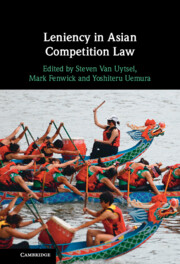Book contents
- Leniency in Asian Competition Law
- Leniency in Asian Competition Law
- Copyright page
- Contents
- Tables and Boxes
- Contributors
- Preface and Acknowledgements
- Abbreviations
- Part I Introduction
- Part II Leniency in Historical, International and Theoretical Context
- 2 The Development of the Leniency Programmes of the United States Department of Justice and the European Commission
- 3 International Guidelines and Best Practices on Leniency Programmes
- 4 Situating Leniency
- Part III Leniency Programmes in Selected Asian Jurisdictions
- Part IV Concluding Remarks
- Appendix Schematic Overview of the Leniency Programmes from Korea, Japan, Singapore, China, India, Taiwan, Malaysia, Hong Kong and the Philippines
- Bibliography
- Index
2 - The Development of the Leniency Programmes of the United States Department of Justice and the European Commission
from Part II - Leniency in Historical, International and Theoretical Context
Published online by Cambridge University Press: 15 September 2022
- Leniency in Asian Competition Law
- Leniency in Asian Competition Law
- Copyright page
- Contents
- Tables and Boxes
- Contributors
- Preface and Acknowledgements
- Abbreviations
- Part I Introduction
- Part II Leniency in Historical, International and Theoretical Context
- 2 The Development of the Leniency Programmes of the United States Department of Justice and the European Commission
- 3 International Guidelines and Best Practices on Leniency Programmes
- 4 Situating Leniency
- Part III Leniency Programmes in Selected Asian Jurisdictions
- Part IV Concluding Remarks
- Appendix Schematic Overview of the Leniency Programmes from Korea, Japan, Singapore, China, India, Taiwan, Malaysia, Hong Kong and the Philippines
- Bibliography
- Index
Summary
This chapter claims that the operation and success of a leniency programme are premised on a carrot-and-stick approach that is expected to lead to a race for confession, as the highest and sometimes only reward – depending on the design of the leniency programme – is for the first cartel member to defect and cooperate with the authorities. The main pre-requisites to instigate this race for confession are the threat of severe sanctions if a cartel is caught, a high risk of detection of a cartel, and a high degree of transparency and predictability in relation to leniency. The chapter then argues that the early leniency programmes of the United States and the European Union have been revised with these pre-requisites in mind. To illustrate the importance of the theory, this chapter than evaluates the most recent version of the respective leniency programmes. The chapter finishes with some thoughts on the similarities and differences between the two leniency programmes.
Keywords
- Type
- Chapter
- Information
- Leniency in Asian Competition Law , pp. 37 - 66Publisher: Cambridge University PressPrint publication year: 2022

